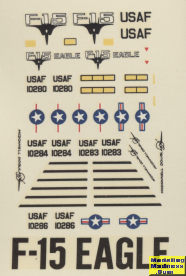
Entex 1/100 F-15 Eagle
| KIT #: | 8521E |
| PRICE: | $ |
| DECALS: | Two optionse |
| REVIEWER: | Scott Van Aken |
| NOTES: | 1977 release |

| HISTORY |
The F-15 Eagle was developed in the late 1960s as a replacement for the F-4 Phantom II, though not a total replacement as the Eagle was to be strictly an air defense airplane. There was no plan on having it perform the fighter-bomber role, that was to be left to what was to become the F-16.
Unlike the F-16 there was no fly-off competition as the plane was ordered right off the drawing board, so to speak. The plane was big and quite powerful, having the most up-to-date avionics and engines. Lessons were learned from Vietnam and it was designed with a 20mm Vulcan cannon installed in the right wing leading edge near the intake. The rest of the armament was four Sparrow missiles and four Sidewinders. It was also able to carry three fuel tanks, one on the centerline and two under the missile pylon, allowing it an impressive range.
Since there was no prototype, several pre-production airframes were built in order to allow the various test units to check out the various systems and determine the full flight envelope of the aircraft. It was during this testing that it was discovered that there were some issues with wingtip stall characteristics and so the wing tips were cut back a bit, this feature improving the handling of the aircraft. This kit represents the Eagle pre-production aircraft before the wing tips were modified.
| THE KIT |
 This kit was originally released in 1974 by a company called Marinen. Next in
line was Mania, then Sanshoh before Entex got ahold of it. This is not the same
as the kit released by Lindberg around the same time as that was a snap kit and
was also a production Eagle.
This kit was originally released in 1974 by a company called Marinen. Next in
line was Mania, then Sanshoh before Entex got ahold of it. This is not the same
as the kit released by Lindberg around the same time as that was a snap kit and
was also a production Eagle.
As to the kit itself, it does have engraved panel lines and they are quite nicely done The interior is just a generic bang seat and that is it. This fits into a separate nose section. Intakes are right and left halves. The upper fuselage also includes the wings. There are inserts for the underside of the wings. Then the lower half is attached followed by the intakes and the nose section.
Fins and tailplanes are then attached along with the two burner cans. Landing gear is fairly well done and by the look of things you can pose this with gear up. There are no wing pylons but there is a centerline pylon with a fuel tank that I don't think any F-15 ever carried. Four Sparrow missiles are also provided for you to attach to the lower fuselage if you wish. A very nice addition, and appropriate for this kit is a well done display stand.
 Instructions are a folded sheet of paper with the 8 construction steps on one
side and two markings options on the other. Neither are the same as the box art,
but no biggie. Both are a base of Air Superiority Blue. One has a lot of daglo
red/orange on the intakes, wings, stabilizers, and tail. The instructions call
this red, but it is daglo. The other only has the daglo on the fin. Decals look
to be well printed, but I have my doubts as to whether they are still viable as
they are nearly 50 years old. Perhaps some Microscale decal film will be able to
make them usable as I can assure you there are no aftermarket sheets.
Instructions are a folded sheet of paper with the 8 construction steps on one
side and two markings options on the other. Neither are the same as the box art,
but no biggie. Both are a base of Air Superiority Blue. One has a lot of daglo
red/orange on the intakes, wings, stabilizers, and tail. The instructions call
this red, but it is daglo. The other only has the daglo on the fin. Decals look
to be well printed, but I have my doubts as to whether they are still viable as
they are nearly 50 years old. Perhaps some Microscale decal film will be able to
make them usable as I can assure you there are no aftermarket sheets.
| CONCLUSIONS |
This is part of the Japanese model industry's attempt to have 1/100 become a standard scale. While that fell flat, this is still a pretty nice kit and worth the effort of building if you are not opposed to a kit in a non-standard scale.
November 2024
Copyright ModelingMadness.com. All rights reserved. No reproduction in part or in whole without express permission from the editor.
If you would like your product reviewed fairly and fairly quickly, please contact the editor or see other details in the Note to Contributors.